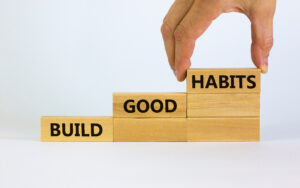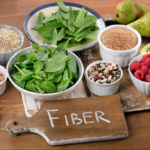Find Healthy Habits that Work for You
Stacey J. Drubner, JD, LICSW, MPH

EAP Ask the Expert: Ellen Braaten, PhD, Executive Director of the MGH Learning and Emotional Assessment Program (LEAP), and Associate Professor of Psychology, Harvard Medical School
If your New Year’s resolutions have started to go by the wayside, fear not. It’s common for this to occur. Research on resolutions is limited, with one study reporting that compliance drops to 55% at 1 month and to 40% after 6 months. There is some consensus that long-term success is possible, but not with a traditional “all or nothing” approach.

Our expert, psychologist Ellen Braaten from MGH agrees. She maintains that it’s a myth that we can’t change behaviors. In fact, anyone can incorporate and keep a healthy habit, leading to sustainable improvement. The key is to have an understanding of who you are, and the knowledge about how to make change. Failure is the result of flawed plans, not flawed people. It’s not a matter of willpower but a function of choosing the right goals and identifying a realistic plan that includes dealing with setbacks.
Choosing the Right Goals
Ellen explains that many of us choose goals that are too big or not specific enough. For example, getting more fit is too general. Instead, plan to exercise 5 times a week. Don’t try to tackle too many things at once. It may be challenging to quit smoking and lose weight at the same time. Choose one and add other goals over time.
Take a step back to consider what habit you want to change or add, and decide if it’s a good match for you. A little work upfront will pay off in the long run.
- What do you want to change about yourself and why?
- Are you invested in this goal?
– Ellen stresses that if you don’t know why you are doing something, it probably won’t be successful. You are less likely to change if you haven’t bought into the idea. - Consider what others, such as healthcare professional or loved ones have identified, based on their concerns about your well-being.
- What kinds of things give your pleasure?
– What did you enjoy doing or have success with in the past? - What comes naturally for you?
- What framework will work best or make sense for you?
- Ellen recommends starting in your comfort zone. If you never run, don’t enjoy running or are not good at this, then don’t pick running as your healthy habit.
- Be careful about choosing goals that rely on others to make change. For example, you may be motivated to decrease alcohol use in your household, but other family members may not share the same interest in this goal. Don’t link your goal to their behaviors. You’ll likely be more successful if you make the goal your own responsibility.
Consider the value of knowledge about health risks as they relate to choosing healthy habits
For some people, it is helpful to understand the risks or benefits associated with lifestyle choices. Education can be a motivator. For example, understanding the connection between weight, diet, and diabetes might influence you to make changes. For others, it may be overwhelming or detract from their ability to meet goals. Focusing on consequences may lead to black and white thinking such as, If I can’t totally stop drinking, I might as well not try at all.
Must you let go of a bad habit to make room for a new one?
Yes, even though it might not be easy. Consider what need the unhealthy habit filled. For example, maybe you have a glass or 2 of wine daily to unwind and relax at the end of the day. Can you identify an alternative ritual that might give you the same benefit without the downsides, (increased risk of breast cancer, disrupted sleep)? Maybe you could go on a walk with a friend or soak in a hot tub.
Make sure you have a plan to meet your goals
Many people fail to maintain healthy habits because they don’t have a plan. They stop at choosing a desired outcome and don’t map out how they are going to get there.
- Be specific with details: I will start with exercising 2 times a week and add one more day every 2 weeks, until I reach 5 days or I will walk on Mondays and do Pilates on Wednesdays.
- Use manageable mini-goals and identify steps.
– A little bit of change is better than none at all. - Making it convenient to make change increases the likelihood of success.
- Know yourself and use that information in your plan:
– Do you work better individually or with others?
– Are you more productive in the morning or at night? - Build your activities into your existing schedule.
– If your gym isn’t close to your house, you are less likely to make it there.
– Stacking habits can be efficient and improve compliance. For example, listen to an audio book while on a walk.
Expect setbacks and plan to revise your goals as needed
Ellen indicates that this is the area where most people fall short. They engage in black and white thinking and don’t view goals as fluid. You should expect setbacks and plan to make modifications.
Things are not always predictable or perfect. We need to be flexible with our goals. Life interferes – you get sick, have responsibilities, or maybe you just forget to work on your healthy habit. An “all or nothing” approach may lead to giving up altogether. If instead, you anticipate that you won’t always meet your goal 100% of the time, you will be more likely to stick with your pursuit of a healthy habit. Go with the flow. Make changes as life changes.
When you get off track, consider whether you should address something else first or just need an alternative plan.
- Maybe drinking too much at night keeps you from getting up to exercise. In this case, drink less or exercise later in the day.
- Maybe walking outside is not convenient because it’s raining or cold. In this case, have a contingency plan to exercise inside.
Maintaining & Building on Improvement

Ultimately, the hope is to transition new behaviors into routines. This means you have formed a habit. In our other healthy lifestyle features, we have discussed the concept of developing muscle memory, in which repeated activities or mindsets become entrenched and automatic. There is no consensus about how long it takes to make meaningful change. It varies, depending on the habit, but most agree it takes at least a few months. Ellen recommends the following to work towards building a routine:
- Be consistent – it is more beneficial to practice a little bit on many days than a lot on a few days.
- As highlighted above, plan for check-ins and be ready to revise as needed.
– How are things going?
– What modifications are needed?
Use accountability to keep on track
- Write down your goal. This increases the likelihood of follow-through.
- Use calendar reminders to keep on schedule.
– Ellen points out that the last 3 years have disrupted the regular schedules to which we were accustomed and diminished easy opportunities for routines. This is particularly true with those with hybrid work schedules. - Use a habit tracking app.
- Connect with a buddy or identify someone with whom you can check-in.

Seek help
Those who have potential medical consequences or are having trouble staying on track might benefit from outside assistance. Seeking support and guidance from an expert (healthcare professional, coach, or trainer) should not be cause for embarrassment. Sometimes we are more compliant with expert input. You may be able to access free sessions at your gym or use insurance coverage.
Should you use rewards?
In general, Ellen recommends moving towards a paradigm in which intrinsic (internal) rewards are enough. For example, if your goal is to limit complaining, the intrinsic benefits are being less negative and generally happier. If we walk more, the intrinsic reward is better balance and more natural vitamin D. When we use extrinsic (external) rewards, it sends a message that the action is not beneficial in itself. This may lead to a reluctance to engage in the behavior. If this is the case, you may need to rethink your goal.
Empowering Kids to Have Healthy Habits

Many of the concepts discussed above apply to kids too, but there are some unique considerations related to motivating kids. Many of these concepts are featured in Ellen’s book, Bright Kids Who Couldn’t Care Less: How to Rekindle Your Child’s Motivation, due out this Month. Here are some highlights:
- Some healthy habits (related to nutrition) are non-negotiable, but others (optional goals) should be more flexible.
- A significant issue is that adults set goals for kids, although they may not understand what kids are actually capable of doing or want to do.
- You should engage your child in the process of developing healthy habits.
- Consider what makes your child unique?
– What does your child do when they have free time & what do they enjoy?
– What activities does your child return to without adult prompting?
– What are they good at, and what do they have the aptitude for? - Change the narrative to help children appreciate the benefits of healthy habits, rather than using a punitive approach or too many external rewards.
You may be interested in our last News Feature with Ellen, Navigating the System when your Child has Dyslexia or other Learning Disability.
Resources
Your goals and how you achieve them are unique to you. Maybe you want to incorporate a healthy lifestyle habit or improve your mental health. Below we offer some resources, many of which include guidance from our internal experts.
- EAP Healthy Lifestyle Resources
- If you want to Improve your Health, Improve your Sleep
- The Drawbacks of Using Alcohol to Cope
- Why is Everyone Talking about Mindfulness
- Getting Back on Track with Healthy Eating
- Healthy Exercise
- EAP Mental Health Resources
Help from the EAP
The EAP offers free and confidential services for employees and immediate household family members. EAP records are separate from medical and HR records. Contact the EAP at 866-724-4327 or request an appointment via our online form for confidential assistance. In-person appointments are available at the following locations. Phone or Video (Zoom) appointments are available from all locations.







